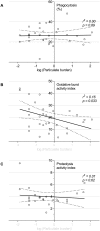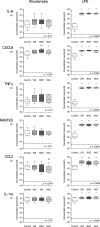Chronic Household Air Pollution Exposure Is Associated with Impaired Alveolar Macrophage Function in Malawian Non-Smokers
- PMID: 26406307
- PMCID: PMC4583259
- DOI: 10.1371/journal.pone.0138762
Chronic Household Air Pollution Exposure Is Associated with Impaired Alveolar Macrophage Function in Malawian Non-Smokers
Abstract
Background: Household air pollution in low income countries is an important cause of mortality from respiratory infection. We hypothesised that chronic smoke exposure is detrimental to alveolar macrophage function, causing failure of innate immunity. We report the relationship between macrophage function and prior smoke exposure in healthy Malawians.
Methods: Healthy subjects exposed daily to cooking smoke at home volunteered for bronchoalveolar lavage. Alveolar macrophage particulate content was measured as a known correlate of smoke exposure. Phagocytosis and intraphagosomal function (oxidative burst and proteolysis) were measured by a flow cytometric assay. Cytokine responses in macrophages were compared following re-exposure in vitro to wood smoke, before and after glutathione depletion.
Results: Volunteers had a range of alveolar macrophage particulate loading. The macrophage capacity for phagosomal oxidative burst was negatively associated with alveolar macrophage particulate content (n = 29, r2 = 0.16, p = 0.033), but phagocytosis per se and proteolytic function were unaffected. High particulate content was associated with lower baseline CXCL8 release (ratio 0.51, CI 0.29-0.89) and lower final concentrations on re-exposure to smoke in vitro (ratio 0.58, CI 0.34-0.97). Glutathione depletion augmented CXCL8 responses by 1.49x (CI 1.02-2.17) compared with wood smoke alone. This response was specific to smoke as macrophages response to LPS were not modulated by glutathione.
Conclusion: Chronic smoke exposure is associated with reduced human macrophage oxidative burst, and dampened inflammatory cytokine responses. These are critical processes in lung defence against infection and likely to underpin the relationship between air pollution and pneumonia.
Conflict of interest statement
Figures





References
-
- Schwartz J, Zanobetti A. Using meta-smoothing to estimate dose-response trends across multiple studies, with application to air pollution and daily death. Epidemiology. 2000;11(6):666–72. Epub 2000/10/31. . - PubMed
-
- Lim SS, Vos T, Flaxman AD, Danaei G, Shibuya K, Adair-Rohani H, et al. A comparative risk assessment of burden of disease and injury attributable to 67 risk factors and risk factor clusters in 21 regions, 1990–2010: a systematic analysis for the Global Burden of Disease Study 2010. Lancet. 2012;380(9859):2224–60. Epub 2012/12/19. 10.1016/S0140-6736(12)61766-8 . - DOI - PMC - PubMed
-
- Dherani M, Pope D, Mascarenhas M, Smith KR, Weber M, Bruce N. Indoor air pollution from unprocessed solid fuel use and pneumonia risk in children aged under five years: a systematic review and meta-analysis. Bull World Health Organ. 2008;86(5):390–8C. Epub 2008/06/12. S0042-96862008000500017 [pii]. . - PMC - PubMed
Publication types
MeSH terms
Substances
Grants and funding
LinkOut - more resources
Full Text Sources
Other Literature Sources
Medical

